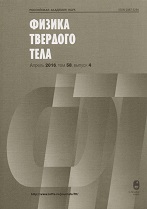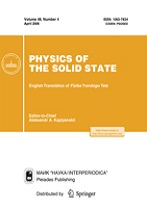|
This article is cited in 8 scientific papers (total in 8 papers)
Optical properties
Long-lived photocatalysis centers created in ZnO via resonant exciton excitation
V. V. Titov, A. A. Lisachenko, I. Kh. Akopyan, M. È. Labzovskaya, B. V. Novikov
Saint Petersburg State University
Abstract:
ZnO together with TiO$_{2}$ is a main photocatalyst for various redox reactions to convert light energy into a chemical one and to purify the environment. Intrinsic surface defects in ZnO–the vacancies in anionic and cationic sublattices (F-type and V-type centers)–allow creation of long-lived (up to 10$^3$ s) photocatalysis centers and, therefore, tenfold increase in quantum yield of reactions. Slow surface states–the photocatalysis centers–appear via diffusion of electrons and holes generated during the interband transitions in the bulk of a photoactivated sample. The transfer efficiency, however, decreases sharply because of recombination of charge carriers and losses during overcoming the surface Schottky barrier. Neutral energy carriers–excitons–were used in this work to decrease these losses during the energy transfer to a surface. High exciton binding energy in ZnO (60 meV) allows it to move at room temperature without decay. The exciton energy loss for radiation is effectively decreased in our experiments via formation of a 2$D$ surface structure. The results confirm high efficiency of exciton channel to form surface long-lived photocatalysis F-centers and V-centers during the photoadsorption and photodesorption processes of oxygen, which simulate full cycle of a redox photocatalytic reaction.
Keywords:
ZnO, excitons, oxygen, photoadsorption and photodesorption, long-lived centers, 2D structure.
Received: 25.06.2019
Revised: 25.06.2019
Accepted: 02.07.2019
Citation:
V. V. Titov, A. A. Lisachenko, I. Kh. Akopyan, M. È. Labzovskaya, B. V. Novikov, “Long-lived photocatalysis centers created in ZnO via resonant exciton excitation”, Fizika Tverdogo Tela, 61:11 (2019), 2158–2162; Phys. Solid State, 61:11 (2019), 2134–2138
Linking options:
https://www.mathnet.ru/eng/ftt8630 https://www.mathnet.ru/eng/ftt/v61/i11/p2158
|


| Statistics & downloads: |
| Abstract page: | 37 | | Full-text PDF : | 9 |
|





 Contact us:
Contact us: Terms of Use
Terms of Use
 Registration to the website
Registration to the website Logotypes
Logotypes








 Citation in format
Citation in format 
